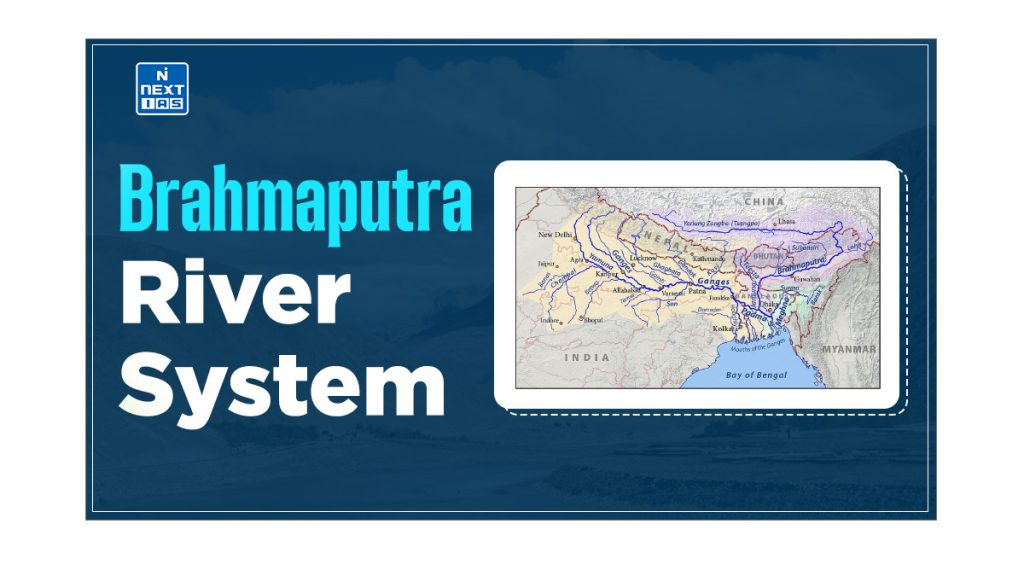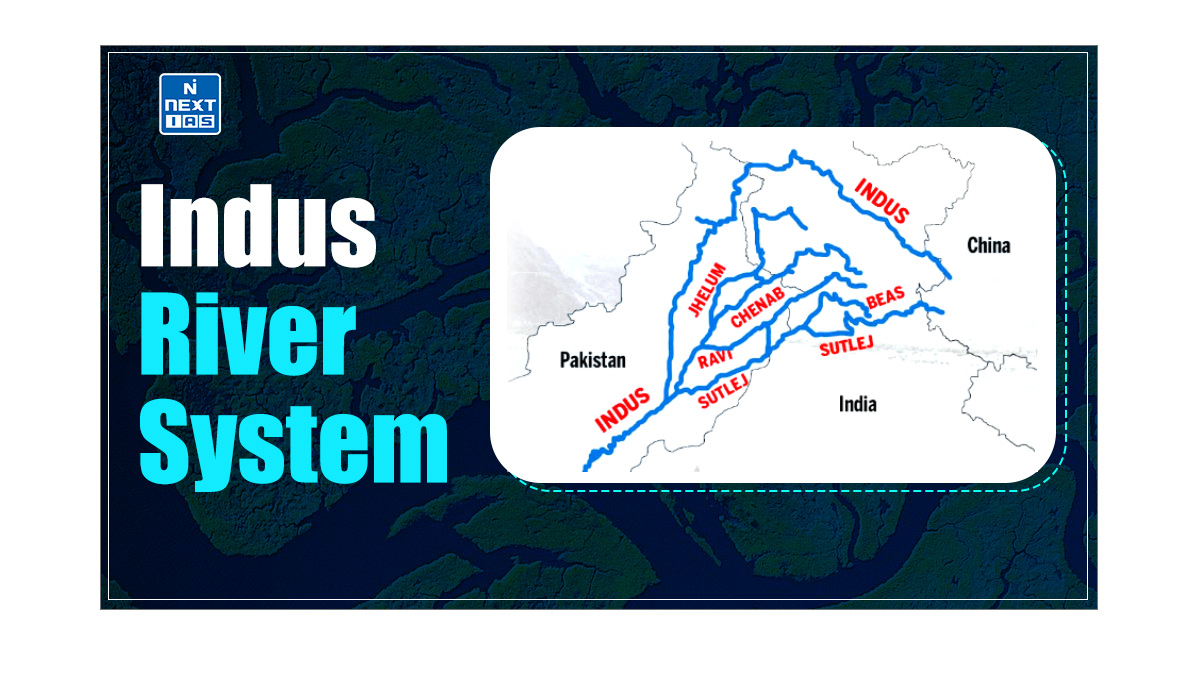
The Brahmaputra River System is a major river system originating from the Tibetan Plateau and flowing through the northeastern part of the Indian subcontinent. Its significance lies in its role in supporting millions of people by providing water for agriculture, drinking, and maintaining diverse ecosystems. This article aims to study in detail the origin, course, and tributaries of the Brahmaputra River System.
About Brahmaputra River System
- The Brahmaputra River System is a vital component of the Himalayan Drainage System, one of the three major river basins in the region.
- The Brahmaputra River, along with its numerous tributaries, flows through the northeastern part of the Indian subcontinent, significantly shaping the landscape and supporting diverse ecosystems along its course.
- Stretching over 2,900 kilometres, the Brahmaputra is one of the longest rivers in Asia and plays a crucial role in the hydrology and agriculture of the areas it traverses.
Origin of Brahmaputra River System
- The Brahmaputra (meaning the Son of Brahma) rises in the Chemayungdung glacier in southwestern Tibet.
- Its source is very close to the sources of Indus and Satluj.
- Despite its exceptionally high altitude, the Tsangpo River maintains a gentle slope.
- It flows sluggishly and features a wide navigable channel for approximately 640 kilometres.

Course of Brahmaputra River System
- The river, known as the Yarlung Tsangpo in southern Tibet, flows through dramatic gorges in the Himalayas and enters Arunachal Pradesh, where it is called the Dihang.
- Just west of Sadiya, the Dihang veers southwest and is joined by the Lohit and Dibang rivers.
- After their confluence, the river takes on the name Brahmaputra.
- It continues through Bangladesh as the Jamuna, eventually merging with the Ganga to create the expansive Sundarbans delta.
| Note: The biggest and smallest river islands in the world, Majuli and Umananda, are in the Brahmaputra River in the state of Assam. |
Tributaries of Brahmaputra River System
The major tributaries of the Brahmaputra River System are:
Left Bank Tributaries of Brahmaputra River
The left bank tributaries of the Brahmaputra River System are:
- Lhasa River,
- Nyang River,
- Parlung Zangbo River,
- Lohit River,
- Dhanashri River, and
- Kolong River.
Some important tributaries of the Brahmaputra River System have been discussed in detail in the section that follows.
Lohit River
- The Lohit River originates in eastern Tibet and travels through the Mishmi Hills to join the Siang at the head of the Brahmaputra Valley.
- The Lohit Valley is densely forested and features a mix of alpine and subtropical vegetation.
- It is also home to a diverse range of medicinal plants.
Right Bank Tributaries of Brahmaputra River
The right bank tributaries of the Brahmaputra River System are:
- Kameng River,
- Manas River,
- Beki River,
- Raidak River,
- Jaldhaka River,
- Teesta River, and
- Subansiri River
Some important tributaries of the Brahmaputra River System have been discussed in detail in the section that follows.
Subansiri River
- The Subansiri River, known as the Gold River due to its renowned gold dust, flows through the Lower Subansiri District in Arunachal Pradesh.
- This fast-moving river is also popular for its excellent kayaking opportunities.
Kameng River
- The Kameng River originates in the Tawang district of the eastern Himalayan mountains.
- It flows through the West Kameng District in Arunachal Pradesh and the Sonitpur District in Assam.
- The river is close to the Pakhui Wildlife Sanctuary and Kaziranga National Park.
Manas River
- The Manas River is a transboundary river that flows through the Himalayan foothills, straddling southern Bhutan and India.
- Originating in Bhutan, it traverses Assam before merging with the Brahmaputra River at Jogighopa.
- The river valley encompasses two significant protected areas:
- the Royal Manas National Park in Bhutan and
- the adjoining Manas Wildlife Sanctuary in India.
Sankosh River
- The river originates in northern Bhutan and flows into the Brahmaputra River in Assam.
- Its upper catchment area is glaciated, while its middle and lower courses traverse V-shaped valleys carved by flowing water.
- The entire catchment area is densely forested.
Tista River
- The river begins at Tso Lhamo Lake in North Sikkim, situated in the Himalayas.
- The Rangeet River, a major tributary, converges with the Teesta River at a location known as Tribeni.
Dibang River
- The Dibang River springs from the snow-clad southern slopes of the Himalayas near the Tibet border.
- It flows out of the hills and into the plains near Nizamghat in the Lower Dibang Valley district of Arunachal Pradesh.
- The upper reaches of the Dibang River are flanked by the Mishmi Hills.
Kopili River
- The Kopili River is an interstate river in Northeast India, flowing through Meghalaya and Assam.
- It is the largest south-bank tributary of the Brahmaputra in Assam.
- The riverbed is home to the rare plant species Carissa kopilii, threatened by a hydroelectric project and acidic water resulting from upstream coal mining in Meghalaya.
Different Names of Brahmaputra River
| Region | Name |
|---|---|
| Tibet | Tsangpo (meaning ‘The Purifier’) |
| China | Yarlung Zangbo, Jiangin |
| Assam Valley | Dihang or Siang, South of Sadiya: Brahmaputra |
| Bangladesh | Jamuna River |
| Padma River: Combined Waters of Ganga and Brahmaputra | |
| Meghana: From the confluence of Padma and Meghna |
States through which Brahmaputra River Flows
In India, the Brahmaputra River flows through the states of:
- Arunachal Pradesh,
- Assam,
- Meghalaya,
- Nagaland,
- West Bengal, and
- Sikkim.
Cities located on Brahmaputra River
The cities situated on the banks of the river Brahmaputra are given below:
- Dibrugarh,
- Pasighat,
- Neamati,
- Tezpur, and
- Guwahati is the important urban centre on the river.

Hydel Power Projects on Brahmaputra River System
| States | Hydel Power Projects |
|---|---|
| Arunachal Pradesh | Tawang, Subansiri, Ranganadi, Paki, Papumpap, Dhinkrong, Upper Lohit, Damway, Kameng. |
| Sikkim | Rangit Hydel Power Project, Tista Hydel Power Project. |
| Assam | Kopili Hydel Power Project |
| Meghalaya | New Umtru Hydel Power Project |
| Nagaland | Doyang Hydel Power Project |
| Manipur | Loktak Hydel Power Project Tipaimukh Hydel Power Project |
| Mizoram | Tuibai Hydel Power Project, Tuirial Hydel Power Project, Dhaleshwari Hydel Power Project |
Conclusion
The Brahmaputra River System and its extensive network of tributaries, diverse ecosystems, and significant cultural heritage underscore its importance. However, the river system faces numerous challenges, including environmental degradation, climate change, and developmental pressures. Addressing these issues requires concerted efforts from governments, communities, and international stakeholders to ensure the sustainable management and preservation of the Brahmaputra River System for future generations.
Frequently Asked Questions (FAQs)
Why is Brahmaputra known as the Red River?
The Brahmaputra is often referred to as the “Red River” due to the high sediment load it carries, particularly during the monsoon season.






